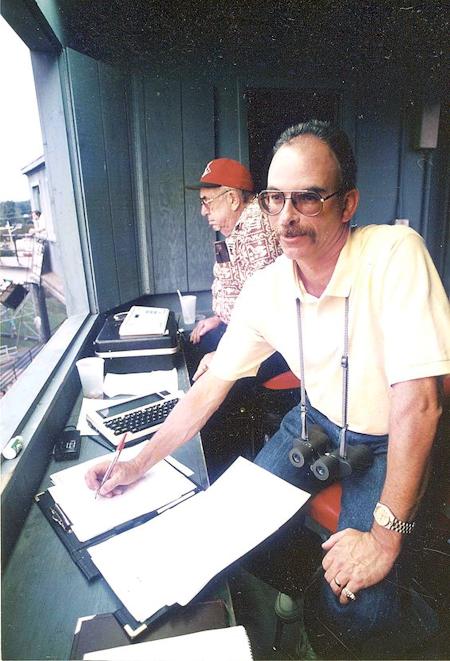The Post-Journal
by Scott Kindberg
April 24, 2016
Riggs Was A Writer With The Right Touch

It’s early March 1980 and I’m driving my parents’ station wagon, accompanied by my 12-year-old brother, Gary, and our friend, Chip Johnson, on a road trip to Erie Community College in Hamburg. The weather is horrible and driving is a challenge, but there is no way we are going to miss the Section VI high school championship basketball game, pitting Jamestown against Lackawanna.
Not a chance.
So what if I spin out three times on Route 20 on the way?
Although there is no damage to the car or to its occupants in any of my mishaps, I wisely surrender the driving to Chip. He gets us to ECC safely and on time, and the three of us wedge our way into the gym where a standing-room-only crowd greets us. As the game plays out, I notice a guy on the baseline, wearing a golf hat and snapping photos of the action on the court.
It’s Post-Journal sports editor Jim Riggs.
Jim doesn’t know me at all, but I sure as heck know him. He’s the guy who just returned from covering the Winter Olympic Games in Lake Placid. He’s the guy who witnessed the United States hockey team knock off the Soviet Union in the semifinals in arguably the biggest upset in sports history and then hold off Finland for the gold medal. Jim is also the guy who covers Nick Creola’s high-flying men’s basketball team at Jamestown Community College where I am a freshman and now he is snapping photos at one of the most important games in Jamestown High School history.
As I sit in the bleachers and watch the Red Raiders run up and down the court, I realize that the biggest assist of the night isn’t a Tyrone Beaman-to-Mark Prechtl pass for a layup. That honor goes to the guy wearing the floppy golf hat with the Canon camera hanging from his neck.
Without him even knowing it, Jim Riggs makes my career choice crystal clear.
ı ı ı
Jim Riggs, 65, died on Saturday morning at Roswell Park Cancer Institute in Buffalo after a courageous battle with plasma cell leukemia. Just typing those words seems incomprehensible to me. Because for more than three decades, he was not only my boss, but he was also my friend and mentor, a man who influenced my career choice AND sold me on the path to get there – Point Park College (now University) in Pittsburgh. In other words, he was the point man for two of my most important life decisions, but he never cared if he got the credit.
And, really, that was Jim.
In a profession in which your work is on display seven days a week, 365 days a year, he was a quiet, private man. If you gave Jim a good book, a good pizza, time with his elaborate model train layout, a 6 a.m. tee time or a Pittsburgh Penguins, Pittsburgh Pirates or Tennessee Titans game on TV, you might as well have presented him with a million dollars.
Generous to a fault, it wasn’t unusual for him to send a card or leave a small gift on the sports desk, just because. He also was blessed with remarkable patience, at least when he and I played golf together at Chautauqua Golf Club where he was a member for more than half a century.
While Jim was the owner of a single-digit handicap and several career holes-in-one, I, in contrast, was a mediocre golfer, at best. Yet, he kept inviting me to join him until I finally “retired” from the game for good around 1990. For those who know Jim and his passion for “the gentleman’s game,” you also know that he liked to play uninterrupted. That’s why he was on the first tee at CGC five days a week just as the sun was coming up. Being there that early, of course, meant that he didn’t have to wait between shots. I guess that’s another reason why he considered me a good playing partner, because I didn’t waste time either. In fact, on one particular morning on the Lake Course, Jim and I completed our round in 2 hours, 8 minutes.
And we walked.
I still consider that my greatest “accomplishment” on the links.
ı ı ı
I visited The Post-Journal’s library yesterday and pulled out an envelope. In it were a handful of articles that either Jim authored or were written about him over the years. One of them was from September 2001. The occasion was his induction into the Jamestown Community College Athletic Hall of Fame. He and George Bataitis were the charter members.
Both men were worthy of such recognition.
Jim followed closely the Jayhawks athletic program until his retirement in December 2014, a span of nearly 40 years. I dare say no junior college in the country received better coverage than what Jim provided the Jayhawks.
“When I started, all there was men’s basketball,” he told me that day. “Women’s basketball had just started. There wasn’t any soccer, there was no volleyball and there was no softball. Now it’s a huge program. It’s nice to be involved with it.”
I chuckled when I read “involved with it,” which may qualify as one of the biggest understatements ever recorded. Pressed further, Jim acknowledged that “it’s nice to know your work is appreciated,” but quickly added that he was surprised to be among the first two inductees into the school’s hall of fame.
“George is a natural because, without George, sports isn’t here,” he said of Bataitis, known affectionately as the “father” of JCC athletics. “A writer (being inducted) is sort of strange, but it’s a big honor.”
But Jim’s impact wasn’t felt only at JCC.
Across campus from the Physical Education Complex is Diethrick Park where Jim spent his summer nights for 35 years covering Jamestown’s entry in the New York-Pennsylvania League. Not only did he cover the team for The Post-Journal, but he also served as the official scorer, a labor of love that is preserved for posterity in thousands of articles carefully filed away in our sports department.
Another file cabinet stores all the articles he wrote in his more than three decades covering the Jamestown High School football team, including state championships in 1994, 1995 and 2000. And, of course, another drawer contains his weekly “All In A Day’s Sports” columns, which have been a Saturday staple since 1975.
It was with curiosity then that I began to flip through the decades-old columns on Saturday. One, dated Oct. 6, 1978, caught my eye. It was the story of Lorne McIntyre, who was a 13-year-old quarterback in the Jamestown Midget Football League that fall.
Under the headline that read, “Midget Football’s Adult Player,” the article chronicled Lorne’s own battle with leukemia that threatened to end his gridiron career almost before it began. But thanks to his treatments, his determination and the care of his coaching staff, particularly head coach Dan Drake, Lorne became one of the league’s best signal-callers.
Wrote Jim: “Just watching Lorne play gives the entire team a lift. When a player gets down on himself or tired, he can look at Lorne and think, ‘If he can do it, I can do it.'”
Ironically, in the last two years, I’ve often thought the same thing about Jim. If he could remain upbeat despite all the physical challenges he faced, then I certainly could do the same.
The column earned Jim a New York State Associated Press Association writing award, one of several he received during his years at The Post-Journal. Now, he’s receiving his ultimate reward for a life well lived in a place where the first tee is clear and his drives are straight and true.
Rest in peace, my friend.
The additional financial assistance of the community is critical to the success of the Chautauqua Sports Hall of Fame.
We gratefully acknowledge these individuals and organizations for their generous support.












